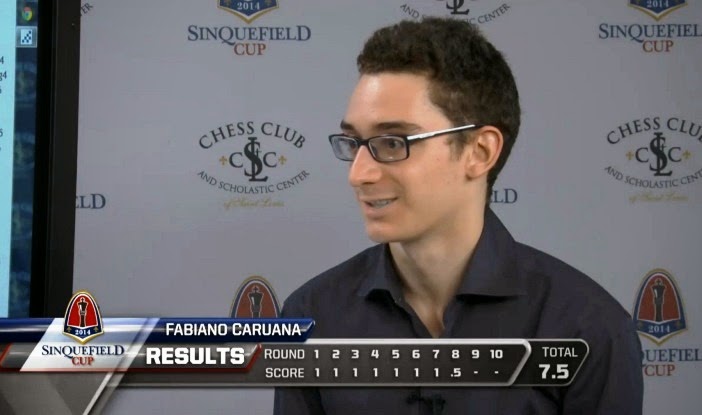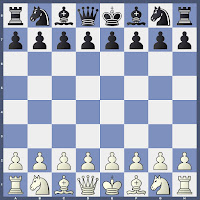7/7 and almost 8/8 at Sinquefield Cup
It was love games until he conceded deuce in the eighth round to World Champion Magnus Carlsen due to an unforced error! He had earlier defeated the world champion in their first game of the ‘set’ when Carlsen played an opening dusted from the history books and succumbed. 7/7 and almost 8/8, Caruana ended his winning streak by drawing the last three games to finish a clear 3 points ahead.
The
margin and its message must have made Magnus Carlsen to sign the contract for "The royal combat in Sochi" just
before the deadline, lest….! After all, the World Champion who perceives chess differently from many others and
stands tall among the greats; is also a human and the thought that someone other than him can achieve such a
feat would have his sense of invincibility shaken a bit and implanted the
question “what if?”
Fabiano
Caruana’s amazing streak in Sinquefield Cup probably surpassed the achievement of the great Alekhine in Baden Baden, 1925 - at least on the table strength of the opposition.
I wish to deal with few of his games played in this tournament to see “why’ he achieved
this phenomenal success, all too sudden!
Generally, people see “how” – which deals with the aesthetic and
sporting angle and is very subjective! I too wish to see how; but the “why” digs deep and reveals certain
objective truths.
We shall see the games in few episodes to betray banality.
Vaselin Topalov
– Fabiano Caruana: Round - 1 (Position after 16)……b6)
The position is in perfect equilibrium. Black has the classical two pawn islands: one
on the king-side and the other on the queen-side and his pawn-less central
squares are well covered by his minor pieces and the pawns on the adjacent c & f
files.
Generally,
the play revolves around the central squares in such positions and the fluid
central pawns of white provide play for both sides: white will try to increase
his hold on the central squares and black will try to apply pressure on white’s
central pawns, whilst trying to create a passed pawn on the queen-side. The
game is still in meandering phase and doesn't call for sharp reactions.
But Caruana’s
solid last move 16…..b6 somehow enticed Topalov to break the equilibrium and he
played…..
17) g4?!
….despite his dislike for going round the corner!!
Stripping
like this was considered obscene till a few decades back; but it is a common occurrence
now: both in chess and in the glamorous world at large!
It
would be interesting to see the ‘rationale’ behind it from Topalov himself; other
than his stillborn intention of bringing his bishop to “g3”! Even the irrational and inanimate computer
does not consider this move as an option - even after ‘revealing it’ and
returning back to 16….b6!
But
we don’t think like machines and that is why we are human; and machines don’t think
like humans, and that is why they are machines.
Topalov’s 17) g4 is like the
aberration that occur in our minds when we stand on top of a multistory building and there the thought of “what will happen if we jump” flashes momentarily before getting doused by our rational thoughts!
On this
instance, Topalov jumped and suffered!
Though,
“moves” constitute a game of chess; I wish to ‘move away’ from the un-played
moves, time and again – unless it demands a mention. I am more interested in what the played “move-meant”!
The
un-played alternatives are like the demons and angels that appear in one’s
dream – at best they can only be a fiction and not fact. If you still want to see the alternatives,
just click on e.n.g.i.n.e.s; they are ever ready to churn out moves for you and
you may indulge in trying to find a meaning for their moves!
Coming
back to the game, after the detour! The
move “g4” exposes the potholes on and around the three pawn islands and Caruana
relentlessly deepens it, assisted by some more ordinary moves from Topalov.
17) ……Be8!
A
good prophylaxis!
18) Be1 b5!; 19) Ne3 Bd6; 20) Ncd5 Nd5;
21) Bd5 Bf7; 22) Nf5 Be5; 23) Qd2?! Nd4; 24) Bf7?
Though
looking ugly in some sublines, I go with the choice of computer 24) e3; where
couple of black’s significant pieces gets exchanged for white’s – especially the
dark squared bishop. And if the knight on f5 is not exchanged, at least it
remains in a strong outpost. White
retains some play in compensation for the compromised structure – at least the
rape would not have been so imminent and immediate!
24) …..Rf7; 25) Rd1?!
25)
Rb1 was better
25)……Nf5; 26) gf5 Qd4; 27) Bf2 Qg4; 28)
Kh1 c4; 29) Qc2 Re8; 30) dc4 Qh5; 31) h4 Qg4
The
last four queen moves by Caruana drilled the nail deep into the coffin.
32) Qd3 bc4; 33) Qe3 Rfe7; 34) b3 Bb2!
This
ensures the passage of “c4” pawn and hence Topalov resigned.
A
fine game where all Caruana needed to do was to ride on the road paved by
Topalov!
Incidentally,
while examining a few games from this opening set up, I stumbled upon a game
played between
Paul Van Der Sterren and Jan Timman, Amsterdam 1996
This
position looks far more formidable for white who managed to get his pawn to “a6”
gaining the outpost “b5” for his knight and he did nothing untoward in front of
his king.
Despite these 'riches', white
was not doing great here too!
Timman
the artist played 15) …..Rb8!? offering
the a-pawn in return for the light squares and activity!
The
play continued
16) Bd2; Be8 17) f4?! ef4; 18) gf4
Ned4; 19) Nd4 Nd4; 20) e3 Nf5; 21) Be4 Nd6; 22) Nd6 Qd6; 23) f5 Rd8; 24) Rf4?
24).....g5!;
A
move invited by white’s last move. This stripping is different from that of
Topalov!
25) fg6 Bg6; 26) Bc3 b5; 27) b4?? Rg8;
28) Kh1 cb4; 29) Bb4 Qf4!;
0-1
0-1
What
was happening in both these games was that white choses a setup where black finds
living very comfortable and suddenly with the rush of blood white indulges in
self-immolation, unable to bear the lightness of the position!
David Bronstein’s commented for a similar un-positional surge
embarked by Gligoric, (playing white against Smyslov in the Zurich 1953
tournament), thus: “It is generally not easy to get an advantage in the cautious
opening Gligoric has chosen for this game, and, having initiated early
simplification, he has arrived at a perfectly drawn position. But now all of a
sudden he starts playing for a win. Chess logic does not allow this. If indeed
the position is clearly in balance, desire alone cannot tip the scales.”
Coming
to our hero Fabiano Caruana, who played Vachier Lagrave in round 2, where he followed
his game played against Evgeny Postny in 2012 upto move 13. He continued further and self-stripped
his king of his pawn cover, which was not to the liking of machine, but Vachier
fell to its glamour and succumbed fast – a game not worth discussing further.
Then
came the moment of this tournament!
Magnus
Carlsen - Fabiano Caruana; Round – 3
1)
e4 e5 2) Bc4!
deserves
a diagram and some digression…way off from the subject!
Mulla
Nasruddin applied for a job on a ship. He was being interviewed, and the
captain and high officials of the shipping company were asking him the
questions.
“If the waters are in a turmoil, and the wind
is blowing very strong and there is a danger of the ship being upturned or
swayed into a direction it does not want to go, what are you going to do?”,
asked the Captain.
“Simple”, Mulla replied, “I will throw out an anchor.”
The
Captain said, “That’s right. But suppose
another storm comes up; what are you going to do?”
“Nothing else; I will throw out another
anchor”, replied Mulla.
The
Captain further asked, “It is right, but
suppose a third storm comes up. What are you going to do?”
Mulla
said, “The same, I will throw out an
anchor.”
And
the Captain asked, “But from where are
you getting those anchors?”
Mulla
Nasruddin replied, “From where are you
getting those storms? From the same place!!”
Tired of the main lines and fear of stepping on landmines, the moves such as Bc4 makes their appearance frequently these days. This move is both the “storm” and the “anchor” from the imaginary world, time travelling five centuries - it made its first appearance in 1575 AD!!
2)……Nf6; 3) d3 c6; 4) Nf3 d5; 5) Bb3
Bb4; 6) c3 Bd6; 7) Bg5 de4; 8) de4 h6; 9) Bh4 Qe7; 10) Nbd2 Nbd7; 11) Bg3?
Anything
is playable, provided you manage to confuse your opponent and be prepared for any
eventuality. Chess is all about how to confuse your opponent, pose problems
and make him go wrong. It was never about “being correct” and one can never be
correct!
But
the unprovoked retreat of this bishop succeed only in giving more clarity to Caruana!
11)….. Bc7; 12) OO Nh5; 13) h3 Ng3; 14)
fg3 Nc5; 15) Bf7?
And
if you are not prepared for some sedate continuation like 15) Nh4, after having initiated such a play and settle
for something unimpressive, then a mere act of escalation would not yield
anything. Cannot help, but quote Bronstein again, even at the cost of
repetition: “It is generally not easy to
get an advantage in the cautious opening Gligoric has chosen for this game,
and, having initiated early simplification, he has arrived at a perfectly drawn
position. But now all of a sudden he starts playing for a win. Chess logic does
not allow this. If indeed the position is clearly in balance, desire alone cannot
tip the scales.”
Over
the board, during the thick of action, a player of the class of Carlsen too can
fall prey for optical illusion and if it is not confusing enough, then your
opponent will start seeing things clearly leaving you to suffer in the illusory
world!
15)……Kf7; 16) Ne5 Kg8 17) Ng6 Qg5; 18)
Rf8 Kh7; 19) Nh8 Bg4!?
Not
sure whether this move or 19) ……Qe3 would work better. In the hindsight both
these moves can be analysed by the engines deep enough and a verdict
reached. But in practice, what is played
over the board throbs with life infused by the aggressors intent and the defenders apprehensions.
20) Qf1 Nd3!; 21) Qd3 Rf8; 22) hg4 Qg4;
23) Nf3?
Probably
this move may be the decisive mistake in conjunction with 25) e6?
23)
Nb3 would have denied black of the opportunity to open up the diagonal c7-h2
where the final act took place!
23)……Qg3; 24) e5 Kh8; 25) e6? Bb6!
I
love this beautiful geometrical sequence of moves that happened on the larger
square bordered by the squares d5 – d1 – h1 – h5, in the reminder of the game. Had Carlsen played 25) Rf1 instead of e6; the
game would have got prolonged.
26) Kh1 Qg4; 27) Qd6 Rd8; 28) Qe5 Rd5;
29) Qb8 Kh7; 30) e7 Qh5; 31) Nh2 Rd1!; 32) Rd1 Qd1; 33) Nf1 Qf1; 34) Kh2 Qg1!
And
black gobbles the “e7” pawn and hence Carlsen resigned to give Caruana his
third win!
By the way, did you notice that in both these games Caruana's queen flirted around the squares on the kingside - in pursuit of white king - to conclude the game: a sheer coincidence!!
(To continue)














.jpg)
.jpg)

Comments
Post a Comment